While there are natural changes at the coast, there are many things that people have done or built to manage the coast. These include:
- Notching
- Planting
- Groynes
- Sea walls
- Importing sand
- Land reclamation
We have learned a lot from what has been done, and you can read more about each approach below.
However, what has been done in the past won’t necessarily be what we want for the future.
-
Dune notching
What is dune notching?
Dune notching involves excavating or digging out gaps in a sand dune to encourage sand to be moved further inland by the wind. These gaps funnel the wind allowing more sand to be transported and deposited behind the dune.
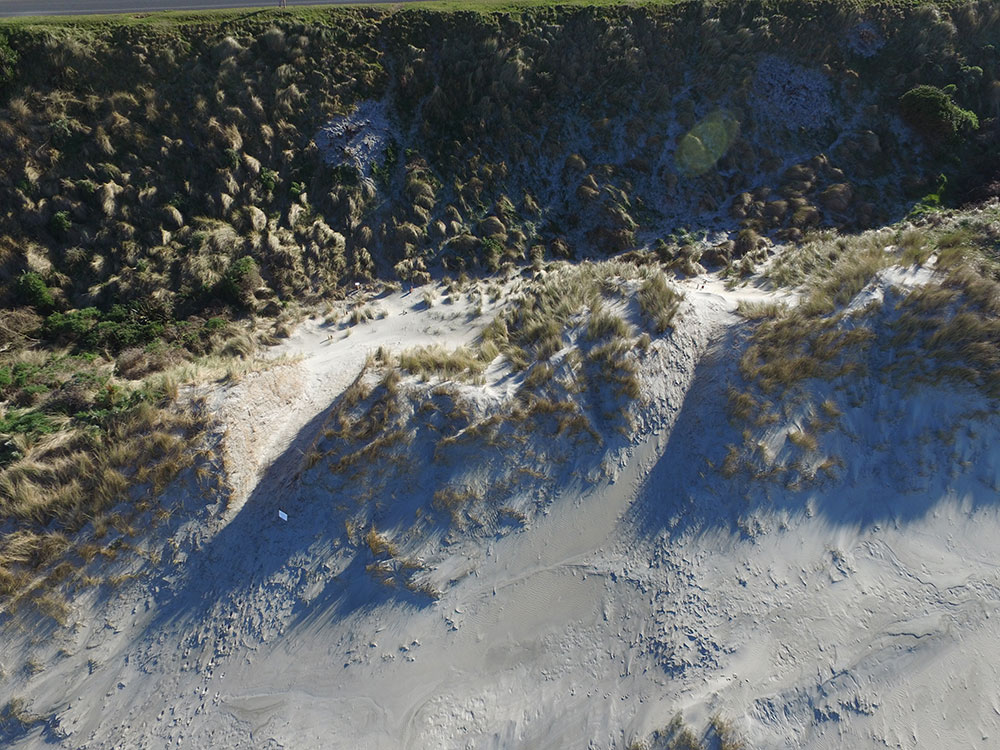
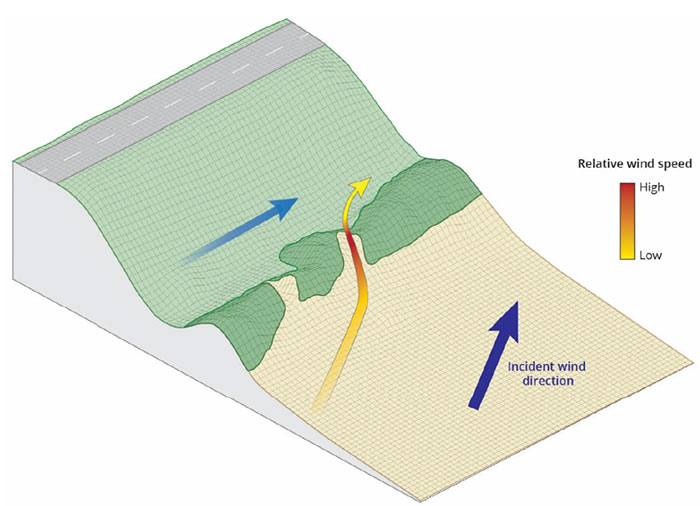
What is the purpose?
It allows more sand to build-up in the sand dune and changes the profile or shape of the dune, so that less sand is located where it might be easily eroded by storms. This process preserves sand and sustains the dunes. St Kilda Beach is the first location in the world where notching has been used for this purpose.
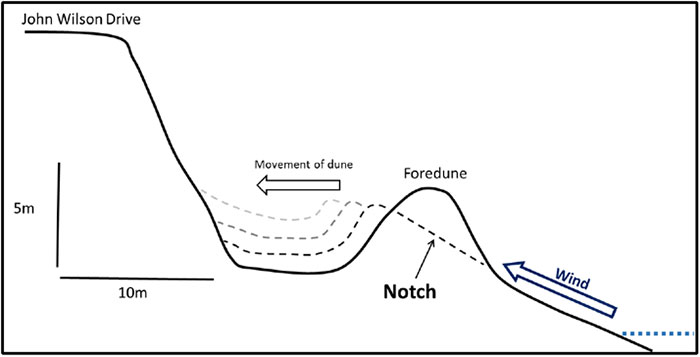
What was involved?
DCC has been working with the University of Otago on notching the St Kilda foredune since 2016. The notching work is ongoing and involves yearly excavation of the dune to allow sand to continue to be added to it.
Was it successful?
Yes – the work is considered a success.In the six months following the original excavation of three notches (in 2016) more than 30 m3 of sand was transported through each one. That is nearly a quarter of a swimming pool worth of sand in only six months and using only three notches! Since this time, a further 30 notches have been dug in the sand dune in front of John Wilson Ocean Drive. Sand continues to be blown through the notches, particularly during strong south-west winds. This has expanded the foredune and, therefore, provides a little more protection to John Wilson Ocean Drive.
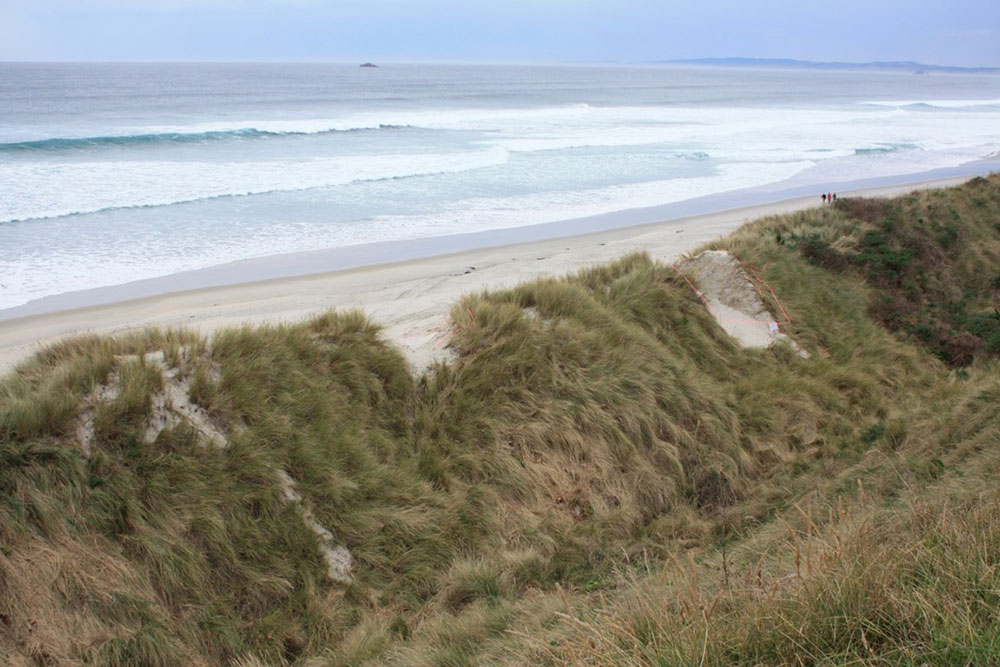
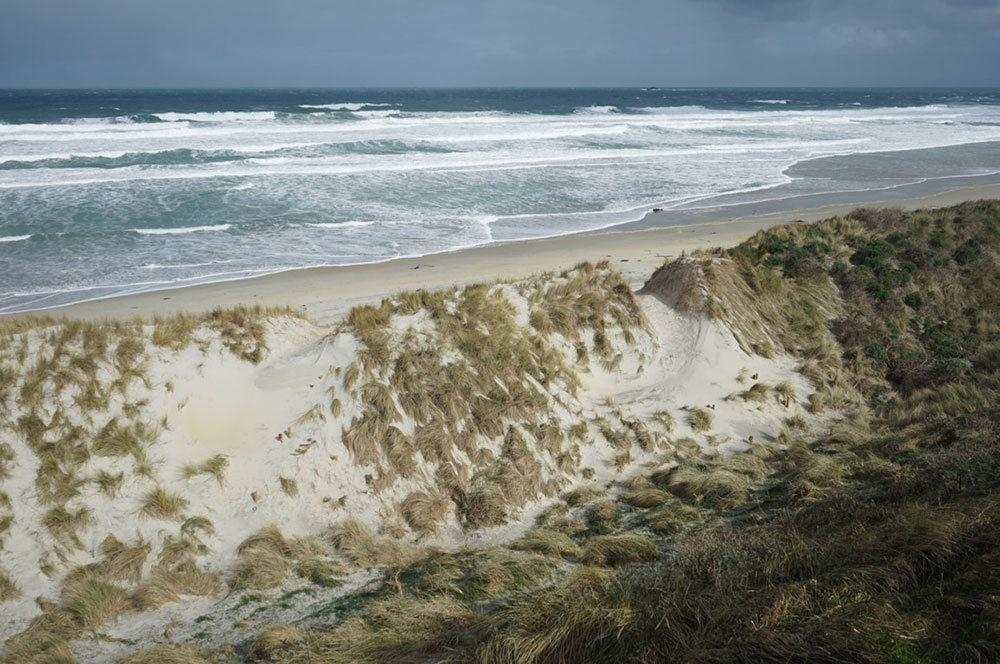
-
Planting in the dunes
What is the purpose of planting?
The planting of vegetation in the dunes and above the high tide mark can help create, re-establish, or stabilise sand dunes. Plants trap sand that is blown by the wind, and this results in sand building-up around the plants. In the right conditions, this can lead to the development of a sand dune. Sand dunes protect the inland areas from erosion and flooding from the sea and provide shelter to wildlife such as New Zealand’s native sea lion.
What was involved?
Many planting activities have taken place at St Clair, Middle and St Kilda Beaches. These have used non-native and native plants. The community has been involved in some small-scale plantings adjacent to Kettle Park and Victoria Road in the past. In 1978, following a series of large storms that removed over 150m of the St Kilda sand dune, a considerable planting effort successfully re-established the sand dune. There have also been extensive plantings prior to this in the 1890s. In these cases the planting was completed to create an area of higher sand dune to stop storm waves and high tides from overtopping and flooding the St Kilda area - which is now protected by a taller sand dune and John Wilson Ocean Drive.
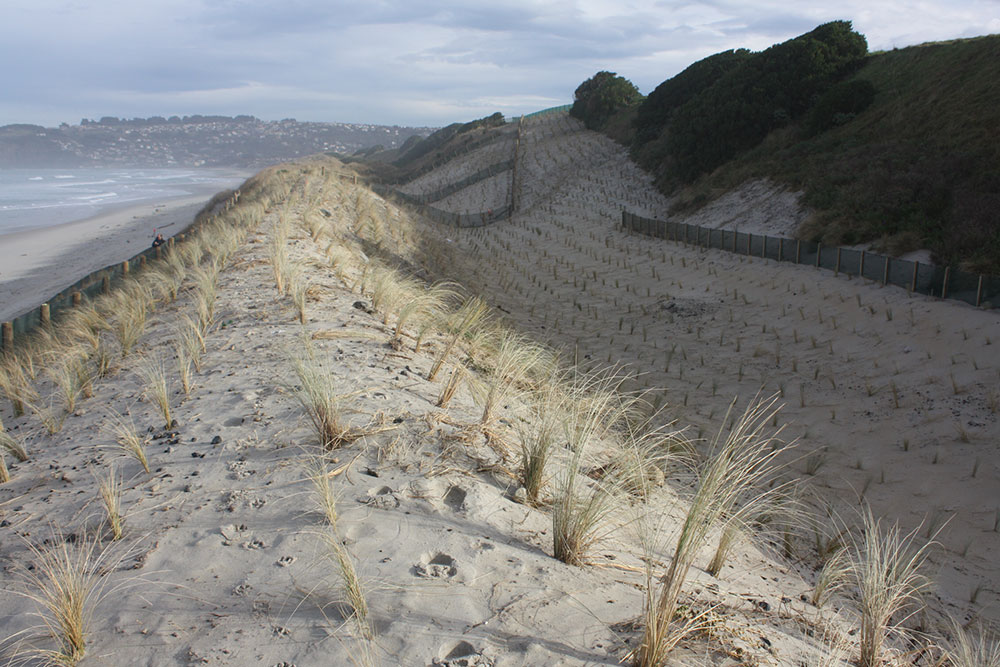
This planting was completed below John Wilson Ocean Drive to re-establish the sand dune following the removal of the Tahuna outfall pipe.
Was it successful?
Planting efforts have generally been successful and have helped in re-establishing areas of sand dune that have been removed/eroded in the past. However, large tides and storms can erode and remove areas of sand dune and wash plants away to sea. Planting has also been successful in helping with more discrete issues such as sand blowing onto Kettle Park.
-
Groynes
What is a groyne?
A groyne is a structure extending out to sea and built perpendicular to the shoreline. Groynes typically extend from the high tide line well into the water. Groynes can be built out of timber, rock or rubble, with most modern-day groynes being built out of rock.
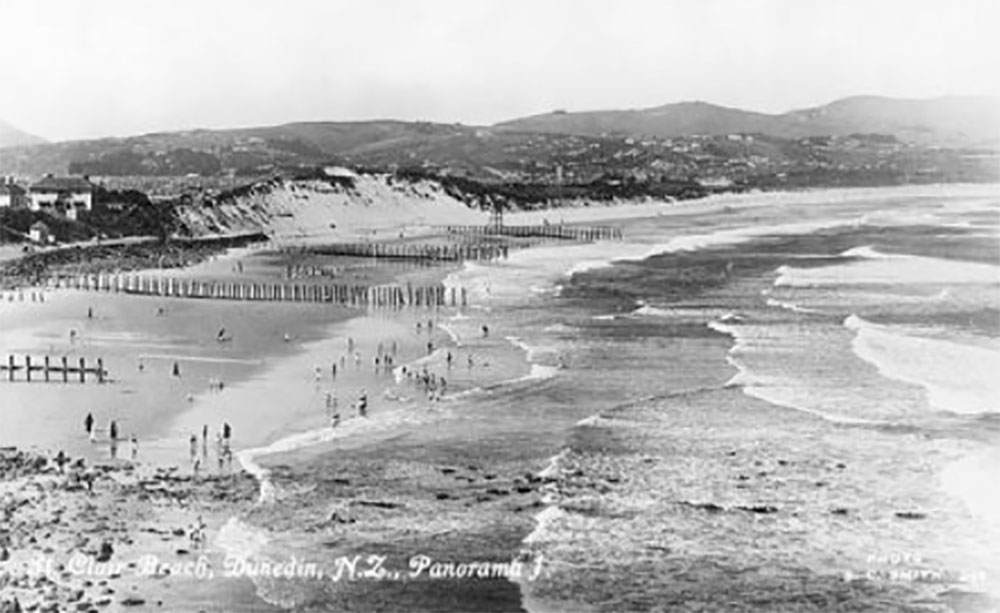
This historic photograph shows a series of wooden groynes on St Clair Beach
What is the purpose?
Groynes function by trapping sand that moves along the beach. As waves move across the seabed they pick up sand, and this sand can be moved up or along the beach depending on the angle of the waves relative to the beach. Groynes can be built to trap this mobile sand and build-up the beach. When working effectively a groyne will trap sand on one side and create a deficit on the other side (erosion). Therefore, the positioning of a groyne, its length, and its durability are all important things to understand, especially in an environment that can be as fierce and high-energy as St Clair.
What was involved?
Several groynes have been constructed at St Clair Beach, with the first being constructed in 1894. In all occasions these structures have been built out of wood and have been located in the areas adjacent to the current sea wall and neighbouring geobags.
Was it successful?
There is some evidence to suggest that groynes have encouraged small amounts of sand build-up during calm conditions. This was at a time where the sea wall was positioned further inland and sea levels were slightly lower. There is evidence to suggest that the timber groynes were not durable enough in the prevailing conditions and performed poorly during storm conditions. Evidence suggests that historic groynes were poorly maintained.
-
Sea walls
What is a sea wall?
A sea wall is a structure built along the shore. Sea walls are typically vertical or slightly angled and are constructed out of timber, steel or concrete.
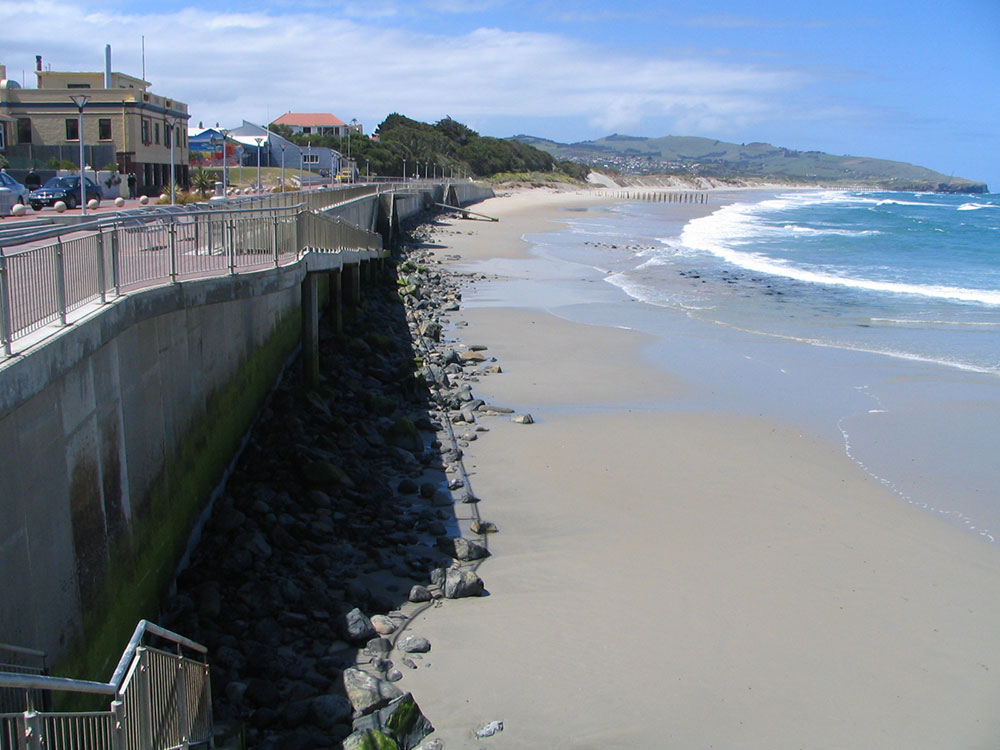
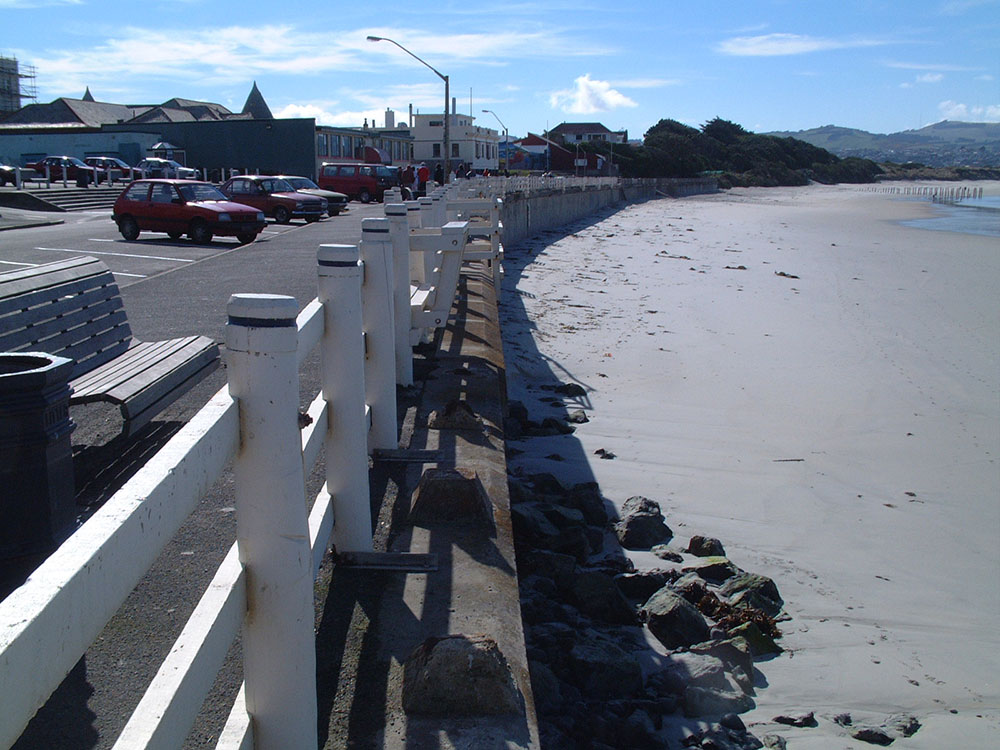
The current St Clair sea wall which is made of concrete and is a vertical structure an the previous sea wall.
What is the purpose?
Sea walls are constructed to protect inland areas from coastal flooding and erosion. Unfortunately, most sea walls also create conditions in the water that actively erode the beach by reflecting wave energy and forcing sand to move away from the wall. This means that sea walls provide protection, but are most likely to reduce the amenity and recreational value of the beach.
What was involved?
The first sea wall at St Clair was constructed in the 1860s as part of the work to establish the Esplanade. Since this time, there have been three other versions of a sea wall, each with different designs and locations and each having different levels of success in terms of protection and impact on the beach. One sea wall built at St Clair in 1884 lasted only two years before being overcome and destroyed by storms. The following sea wall lasted considerably longer and remained in operation for a most of the 1900s. The current sea wall and esplanade was constructed in 2004. It is a vertical structure that has been damaged by storms. Access to the beach from the sea wall itself is unsafe during stormy conditions, partly because the beach has dropped due to the erosive effect of the wall. It is expected that the bottom of the wall will be permanently underwater at low tide before 2050.
Was it successful?
Sea walls at St Clair Beach have provided protection against coastal flooding and have protected the St Clair Esplanade. However, each subsequent sea wall has been progressively built closer to the sea than the last. As a result, the natural/historic high tide line actually sits well inland of the current sea wall. This pushing of infrastructure towards the sea has contributed to the lowering (erosion) of the beach and the progressive loss of the amenity value. The use of vertical structures for sea walls has made beach erosion worse and meant that the energy in the waves is still very high when they hit the wall. Unfortunately, there is also a phenomenon called “end wall effect”, which is where erosion of the coast and dunes actually increases at the end of the wall. We have seen this happen at St Clair.
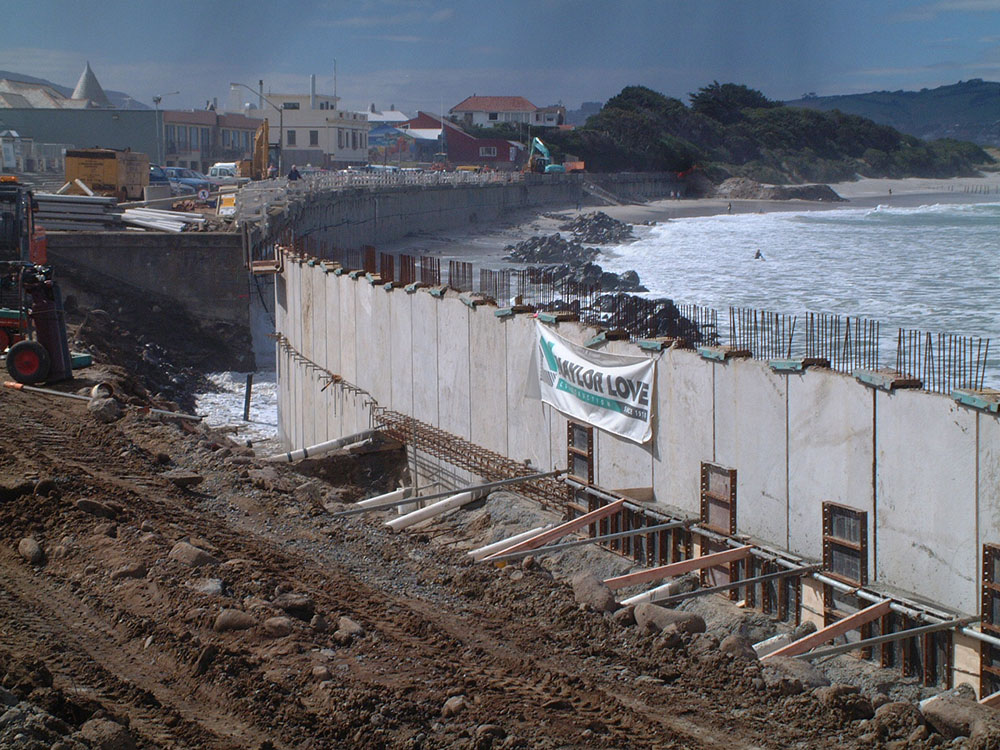
This photo shows the construction of the current sea wall in front of the previous wall. The western-end near the salt water pool was pushed many metres onto the beach.
-
Importing sand
What is importing sand?
This is the process of moving sand from a location where there is a good supply and placing it on or close to a beach that needs to be built up.
What is the purpose?
The purpose of importing sand is to build up the beach and to protect the dune and land area from tides and waves that might otherwise cause erosion.
What was involved?
The DCC has completed small sand importing exercises in the past, both at St Clair and Middle Beaches. In all cases, this work was completed reactively to protect areas of dune and land that had been eroded by storms. In the past, this sand has been taken from the Otago Harbour and Island Hill sand dune (near Waldronville). Neither of these sources are suitable for building up St Clair or St Kilda Beaches in the long term for recreation.
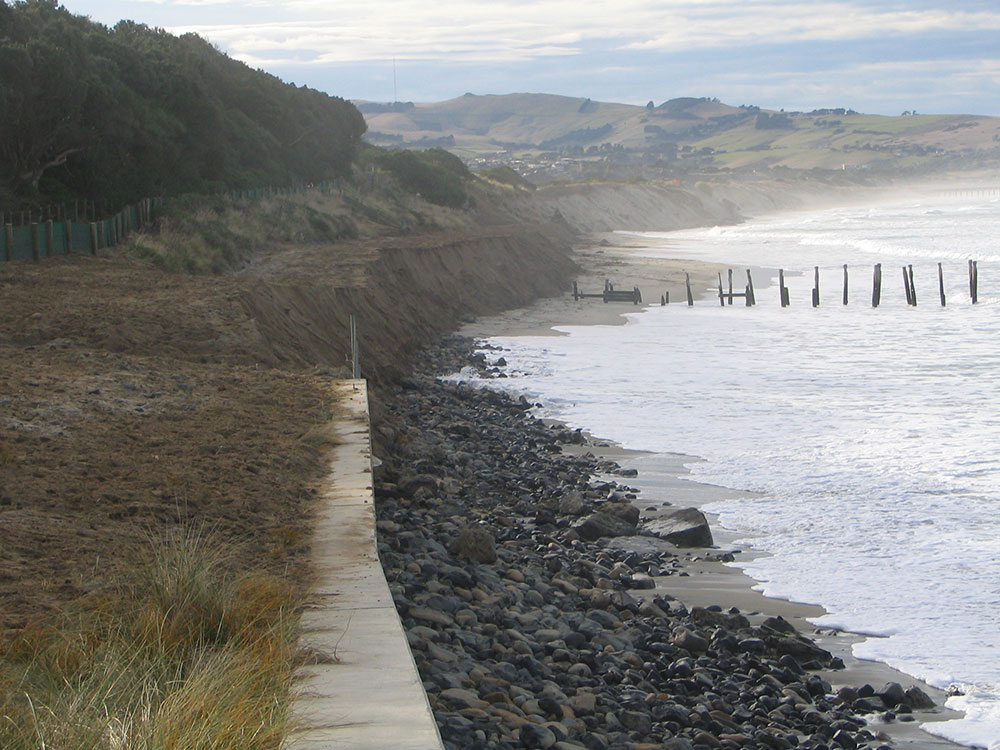
The browner material in this photo is sand that was brought to the beach to minimise erosion.
Was it successful?
Importing of sand has been successful in mitigating erosion in the short-term and protecting critical areas such as Moana Rua Road. However, the imported sand has generally been washed away within weeks/months and, therefore, any benefits have been short-lived. It is important that imported sand is not finer (smaller grains) than the beach where it is being placed – if the sand is too fine it will be washed away very easily.
-
Land reclamation and changing landuse
What is land reclamation?
Over several hundred years, humans have changed the land along the St Clair to St Kilda coast by draining swamps and wetlands, altering the dunes, and levelling the land behind the dunes using sand and rubble.This process of changing the beach and dunes has created land for housing, businesses, recreation, and transport. For instance, the St Clair Esplanade, Kettle Park playing fields, and John Wilson Ocean Drive are all examples of things that would not be there if land had not been “reclaimed” from the sea, beach, and dune system.
What is the purpose?
The reclamation of land along this stretch of coast has taken many forms, e.g. dune planting, construction of sports fields and the progressive pushing of sea walls towards the sea. The overarching purpose of each of these actions have been to create more flat/useable land; a process that was started by the Ocean Beach Domain Board in the late 1800s.
What was involved?
This reclamation began in the 1890s when marram grass was planted to stabilise areas of beach around St Kilda. This reclamation then became more aggressive, with the construction of Victoria Road beginning in the early 1900s, followed later by the forming of sports fields and construction of groynes on St Clair Beach as well as houses in the inland area.
Was it successful?
One of the overarching management challenges for this coast is that coastal lands and infrastructure have been squeezed between the sea and inland development. So, while land reclamation has provided more useable spaces, it is also the main cause for why the beach and dune areas are so readily impacted by storms - they simply do not have enough space.
